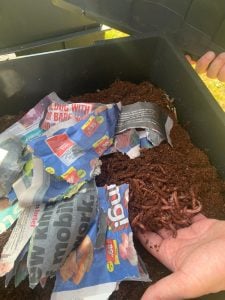In addition to Loreto’s wonderful honeybees, the College is pleased to welcome earthworms to the campus, which are housed in two wormeries outside Ward Building. 
Our wormeries, which are in multiple compartments, consist of a lid, composting trays where the worms (Eisenia fetida) live, a drilled tray where the humus will build up, and a plastic tap for emptying the humus. Worms produce castings from digesting vegetative waste, creating 100% organic matter called humus. In soil science, humus can be described as dark organic matter rich in nutrients and is formed by the decomposition of plant and animal matter.
Our expert in the matter, William Cutforth, explains in greater detail:
“Humus produced by worm composting is vital to soil health. The environment recreated inside a worm composter is also perfect for soil microbes that are useful in breaking down organic compounds. Microorganisms break down these compounds into inorganic minerals that can be absorbed by plant roots. One of the most important groups is Rhizobium, which recycles nitrogen from these compounds. Rhizobium and other similar bacteria are in a symbiotic relationship with legumes and can increase nitrate uptake drastically. Other bacterial groups can break down phosphate ions. Nitrogen and phosphorus fertilisers are the most commonly used fertilisers and cause damaging effects to local ecosystems. Soils with healthy humus, produced by earthworms, bacteria and fungi, have a much lower requirement for these fertilisers and therefore, support local environments better. In essence, humus is a carbon sink, lowering emissions by breaking down carbon compounds into useful products for soil and plants.
Healthy soils, aided by humus, improve soil structure by increasing surface area. This increase in surface area allows for more nutrients to be held for plant use. It also has the added effect of being able to retain large amounts of moisture, reducing the risk of waterlogged soil and flooding. Lowering the risk of flooding and mitigating local climate change is one of the most pressure issues for local communities.”
So worms can reduce food waste, produce nutrient-rich humus, which can then be added to soil as a carbon sink and reduce the risk of flooding. What can’t they do?
 Unfortunately, worms are vulnerable to a few environmental factors:
Unfortunately, worms are vulnerable to a few environmental factors:
- Worms process food at a reasonably quick rate, given their body size, eating half their weight in waste each day. However, given how much smaller they are compared to us, we need to be careful with how much food waste we give them.
- Worms do not have lungs and instead breathe through their skin. The waste must remain wet, but not so much so that it causes drowning.
- Our worms also require a pH with an approximate range of 5-8 pH.
- Worms consume more food during the warmer seasons and are less active during the colder seasons. Extremes in temperature can result in the loss of our worms.
- They can be fussy eaters. Meat, garlic, onions, and citrus fruits should be avoided if possible. They can’t be given bones, dairy products, oil, soaps, grass cuttings and no insecticides or pesticides. While giving cut flowers to worms may seem like a good idea, it is best not to, as these may have been treated with pesticides.
The RHS has more information on worm composting on their website, and the Soil Association explains why soil matters.